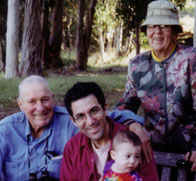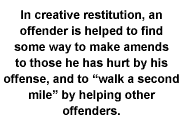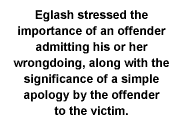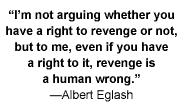The concept of creative restitution was developed by psychologist Dr. Albert Eglash in the 1950s. While working with adults and youths who were involved in the criminal justice system, Eglash found that the system lacked both humanity and effectiveness. As a proposed alternative to that system, he developed and promoted the concept of creative restitution. In creative restitution, “an offender, under appropriate supervision, is helped to find some way to make amends to those he has hurt by his offense, and to ‘walk a second mile’ by helping other offenders.”[1]
Some of the basic tenets of restorative justice can be found in the principles of creative restitution, as can the philosophical heart of a variety of restorative practices programs. For this reason, Eglash’s work on creative restitution has been acknowledged by some as one of the foundations of the restorative justice movement.
 |
| Dr. Albert Eglash (left), with his son, Ronald, his grandson, Isaac, and his wife, Evelyn. |
Eglash was interviewed in August 2003. Asked what had inspired the concept of creative restitution, he said, “The concept of restitution had been around a long time, but in a very narrow sense. It simply meant paying money. I just expanded it.” Asked if he saw a connection between creative restitution and restorative justice, Eglash said, “Yes, I think they’re the same thing. I think the restorative justice movement has moved my concept in a very constructive direction, far beyond what I had conceived.”
In the 1950s, in Detroit, Michigan, U.S.A., while working with the Mayor’s Rehabilitation Committee on Skid Row Problems and the Commission on Children and Youth, Eglash counseled destitute alcoholics and attended Alcoholics Anonymous (A.A.) meetings. He was very impressed with the fellowship he saw among A.A. members, and their practices provided inspiration for the idea of creative restitution. “A.A.’s Twelve Steps program includes two steps about making amends,” he said.
At the same time, Eglash met “Tip,” an alcoholic with an extensive criminal and prison background who wanted to find a way to make amends for the things that he had done. Eglash and Tip provided leadership to a Twelve Steps program for delinquent teenagers called Youth Anonymous, and Eglash performed a follow-up study of the youths who had participated in the program. He also co-conducted meetings of Adults Anonymous, a support group program for prisoners, based on the tenets of A.A. He promoted the use of creative restitution with prisoners and parolees, discussed the concept among them and recorded their comments.
In an early article, Eglash spelled out the characteristics of the restitutional act:
“1. It is an active, effortful role on the part of an offender. On New York’s Riker’s Island, inmates of the city penitentiary risked their lives to rescue passengers of a plane which crashed and burst into flames during a snowstorm. Restitution is something an inmate does, not something done for him, or to him. …
2. This activity has socially constructive consequences. … From prison labor wages and savings, Ionia (Michigan) inmates sent money to foster parents. Being constructive, restitution may contribute to an offender’s self-esteem.
3. These constructive consequences are related to the offense. … Being offense related, creative restitution may redirect in a constructive manner those same conscious or unconscious thoughts, emotions or conflicts which motivated the offense.
 4. The relationship between offense and restitution may be reparative, restorative. In San Quentin, Jim asked to earn the $50 necessary to make good a bad check. Being reparative, restitution can alleviate guilt and anxiety, which can otherwise precipitate further offenses.
4. The relationship between offense and restitution may be reparative, restorative. In San Quentin, Jim asked to earn the $50 necessary to make good a bad check. Being reparative, restitution can alleviate guilt and anxiety, which can otherwise precipitate further offenses.
5. The reparation may leave the situation better than before the offense was committed. A youngster destroyed a neighbor’s rural mailbox; police turned him over to his parents. Boy and father together replaced the box on its post. The next day, the boy asked for paint and brush, left the box in better condition than before the offense occurred.”[2]
Eglash listed further attributes of creative restitution, which “distinguishes it from reparations or indemnity:
1. It is any constructive act.
2. It is creative and unlimited
3. It is guided, self-determined behavior.
4. It can have a group basis.”[3]
After discussing creative restitution with adults in a county jail, youths in a correctional facility, adult pre-parolees in a house of corrections and other juveniles and adults involved in criminal circumstances, Eglash concluded that the concept: “makes sense to adult offenders and is more acceptable to them than is mandatory restitution. They believe that incarceration discourages restitutional effort, since it provides a codified (ritual) restitution. They are leery about approaching the victim, who may be vengeful, and welcome the help of a parole officer in this matter. Restitution occurred to many before incarceration. Juveniles are even more frightened of facing their victims. … [They] seem not to have been made aware—by parents, school, police or court—that making amends to those we hurt is part of our growth.”[4]
Eglash addressed some of the basic elements of restorative justice in his thoughts on creative restitution. On the importance of restoring the relationship between the offender and the victim, he wrote, “At present, offenders are not encouraged to make contact with their victim at any time, either on probation, in prison, on parole or after discharge, but experience with creative restitution suggests that a victim may become an offender’s best friend, an important human resource for help in reestablishing self-respect and in reintegrating with society.”[5] Eglash was optimistic that creative restitution might help with the stigma felt by prisoners after they had been released from confinement. He hoped that reconciliation with the victim would “provide a gateway to comfortable relations with others.”[6]
Another important component of creative restitution is the idea of the renewal of self-respect. “Certainly one of the first objectives for the offender … is the bolstering of his feelings of self-worth,” wrote Eglash (with Paul Keve[7], then director of Hennepin County Probation Department, Minneapolis, Minnesota, U.S.A.), adding, “So much has happened to [an offender] to weaken or destroy that sense of worth. In the beginning, perhaps, a rejecting parent; then problems in school that added to feelings of inferiority; then failures in jobs, discord in marriage, or a variety of other sources of trouble. … And now to have been arrested, jailed, tried and found guilty seems to say to the defendant all over again, in the most concrete ways, that he is an inferior object with no right to look at himself with pride or hope.”[8]
The article quoted above tells a story about an instance of unplanned creative restitution. “Steve” had a juvenile court record but had gone on to become a successful plumber and family man. Then one day he fell back into his old ways, when he stole some copper tubing and was caught. At this point, Steve “felt disgraced and discouraged nearly to the point of just not caring anymore.”[9]Per court order, Steve began making payments to the complainant for the tubing, but the act of paying monetary restitution did nothing to end his despair. One day while waiting to meet with the victim of the theft, “McCormick,” to make a payment, Steve overheard him saying he needed volunteers to build a playground and offered his help. As Steve became involved with the playground project, “his feeling of being a pariah was rapidly dispelled. …”[10]and his relationship with McCormick was repaired. Eglash envisioned creative restitution as a way to provide a deliberate opportunity for offender and victim to restore their relationship, along with a chance for the offender to come up with a means to repair the harm done to the victim, such as community service.
Eglash also stressed the importance of an offender admitting his or her wrongdoing, along with the significance of a simple apology by the offender to the victim. Again, he said he drew inspiration from A.A.’s Twelve Steps, writing, “Step 10 of the Alcoholics Anonymous program suggests that ‘When we were wrong, we promptly admitted it.’ Steps 8 and 9 suggest that ‘We made a list of all persons we had harmed and became willing to make amends to them.’”[11]
 It was another A.A. practice that inspired Eglash to advocate the notion of mutual help. “One way of making restitution for the harm we have done is by helping others with the same problems as our own,”[12 ]he wrote. “At present, mutual association between offenders is discouraged or even prohibited, and may constitute a violation of probation or parole. But creative restitution encourages such mutual association: if alcoholics can help each other leave liquor alone one day at a time, perhaps offenders can help each other leave other things alone one day at a time. … Perhaps an offender is an effective person for getting through the defenses and resistances of another offender.”[13 ]
It was another A.A. practice that inspired Eglash to advocate the notion of mutual help. “One way of making restitution for the harm we have done is by helping others with the same problems as our own,”[12 ]he wrote. “At present, mutual association between offenders is discouraged or even prohibited, and may constitute a violation of probation or parole. But creative restitution encourages such mutual association: if alcoholics can help each other leave liquor alone one day at a time, perhaps offenders can help each other leave other things alone one day at a time. … Perhaps an offender is an effective person for getting through the defenses and resistances of another offender.”[13 ]
Eglash pointed out another benefit of mutual help. “Because restitution can be a group process, time demands on leadership, e.g., on probation officers, can be reduced. … Probationary guidance may be easier with a group than with an individual. In committing an offense, what a youth would not do alone he tackles when supported by his group.”[14]
Eglash put the group process to work when he initiated the first meeting of Youth Anonymous, in January 1955, at Boys Republic, “a private training school for boys 13 to 16 who had failed to benefit from other corrective action.”[15]Eglash’s friend and coworker, Tip, ran the gathering along the lines of an A.A. meeting, beginning with telling his personal story of crime, imprisonment and alcoholism. Tip then asked the boys what they wanted to name their program, suggesting, “Delinquents Anonymous.” The boys didn’t like the idea. Tip asked them why not, explaining that alcoholics call their group “Alcoholics Anonymous.” “Yeah, but they don’t call themselves ‘Drunks Anonymous,’”[16]replied the boys. Rejecting the stigma of delinquency, the boys settled on “Teenagers Anonymous.” A second group, which met at the Michigan Department of Corrections Brighton Youth Camp, selected the name “Youth Anonymous” (Y.A.). Neighborhood Youth Anonymous groups formed as well, open to both boys and girls, as did a parents’ auxiliary. The program’s goal was to enable youths whose behavior had set them apart to rejoin their peers.
The youths participated enthusiastically in the Y.A. groups. They heard speakers from A.A., as well as adults who had been in trouble, and helped each other deal with their problems, informed by discussion of some of A.A.’s Twelve Steps. In 1956, Eglash wrote, “In a high delinquency area of Detroit, concerned observers have commented that there has been a noticeable decrease in serious juvenile offenses since the establishment of a group there.”[17]
In 1961, Eglash began follow-up interviews with as many former Y.A. participants as he was able to contact. Attendance at Y.A. meetings seemed to have had a lasting positive effect on many of them. He obtained the following comments from former members. Before Y.A.: “Before, somebody would say something, I’d belt him one.” “I was on probation for B&E (breaking and entering)—it was 33 B&Es. … I used to run away from home and steal cars.” About Y.A.: “It was something I was in, not just one person talking, everyone; if you wanted to say something, you could; you could even be a leader.” “It keeps you off the streets and out of gang fights. We’d talk and learn that you have to help other people keep out of trouble if you want to keep out of trouble yourself.” After Y.A.: “I walk down the street and think about crazy things to do, give people a hard time, then I think again, and now I don’t do it.” “The guys wanted to break into a house boat. I talked them out of it.”[18]
In the interview, Eglash referred to a new manuscript—a work in progress. “Armed Conflict as Fixation: Twenty-one Steps Toward Peace” applies concepts of creative restitution, which are closely related to restorative justice, to the ancient problem of how to end war.
Just as he advocates direct communication between offenders and victims to repair the harm between them, Eglash, recognizing the common humanity of the citizens of combating nations, proposes that those directly involved in the world’s conflicts have the opportunity to restore relations between them. Consequently, he suggests that peacemakers be chosen from among families of those who have been killed. He cites the example of an Israeli father whose son was killed by Palestinians and a Palestinian father whose son was killed by Israelis who organized a group called Pain for Peace. Furthermore, if ex-alcoholics are the best people to help alcoholics, and ex-offenders are effective in helping others avoid criminal behavior, Eglash suggests that ex-terrorists might be appropriate to lead others on the path to peace.
Creative restitution stresses the importance of apology in restoring harm between offenders and victims, and Eglash sees the same value in nations apologizing to each other for the “brutal, cruel, savage things each side does to the other.”[19] The refusal by nations to make such apologies is, he believes, one reason that conflict endures. And, he thinks, as important as it is to apologize, it is equally imperative that apologies be accepted when they are offered. “Accepting apologies implies dropping grudges, resentments and revenge. Instead, it suggests forgiveness…”[20]The notion of making amends for harm done, another concept central to creative restitution, is also seen as a vital step toward peace.
But perhaps the most important step toward peace, one that is fundamental to restorative justice, is the willingness to renounce retribution. Eglash cites the never-ending cycle of retaliation between Israel and Palestine and that between Catholics and Protestants in Northern Ireland as examples of the endless demand for retributive justice which must cease. This is where the notion of forgiveness comes into play. “In order to forgive,” writes Eglash, “we distinguish between people and their behavior, so that we can forgive the people, not their behavior.”[21]
 Finally, Eglash asserts that peace is a human right, and challenges those who maintain that people have a right to revenge. “Revenge—retributive justice—may be a strong emotion, a strongly desired goal, a universally bitter emotion,” he writes, “but none of this makes it a human right belonging to surviving victims. Enjoying the flavor of getting even pits individual satisfaction against a nation’s aspirations to live in peace with its neighbors.”[22]
Finally, Eglash asserts that peace is a human right, and challenges those who maintain that people have a right to revenge. “Revenge—retributive justice—may be a strong emotion, a strongly desired goal, a universally bitter emotion,” he writes, “but none of this makes it a human right belonging to surviving victims. Enjoying the flavor of getting even pits individual satisfaction against a nation’s aspirations to live in peace with its neighbors.”[22]
During the interview, Eglash talked about those who take a negative attitude toward restorative justice and believe in revenge. “They’re saying that one of the human rights is revenge; if you’re a victim, then you have a right to revenge. I’m not arguing whether you have a right to revenge or not, but to me, even if you have a right to it, revenge is a human wrong.”[23]
We are grateful to Dr. Eglash for taking the time to speak to us about his work on creative restitution. Begun nearly half a century ago, it remains as useful and important today.
REFERENCES
[1] Eglash, A. (1958a). Creative Restitution: Some Suggestions for Prison Rehabilitation Programs. American Journal of Correction, 20, 20-34.
[2] Ibid.
[3] Eglash, A. (1958b). Creative Restitution: A Broader Meaning for an Old Term. Journal of Criminal Law, Criminology and Police Science, 48: 619-622. Reprinted in: Hudson, J. & Galaway, B. (Eds.). (1975). Considering the Victim: Readings in Restitution and Victim Compensation. Springfield, Illinois: Charles C. Thomas.
[4] Eglash, A. (1959?). Offenders Comments on Creative Restitution. Journal Unknown.
[5] Eglash, A. (1958a).
[6] Ibid.
[7] Keve went on to become Commissioner of Corrections for the states of Minnesota and Delaware, professor at Virginia Commonwealth University and author of several books on corrections.
[8] Eglash, A. & Keve, P. (1957). Payments on “a Debt to Society.” N.P.P.A. News: A Publication of the National Probation and Parole Association, 36, (4).
[9] Ibid.
[10] Ibid.
[11] Eglash, A. (1958a).
[12] Ibid.
[13] Ibid.
[14] Eglash, A. (1958b).
[15] Eglash, A. (1958c). Youth Anonymous. Federal Probation. 22: 47-49.
[16] Ibid.
[17] Ibid.
[18] Eglash, A. (2000). Critical Incidents in Youth Anonymous. Unpublished manuscript.
[19] Eglash, A. (2003). Armed Conflict as Fixation: Twenty-One Steps Toward Peace. Unpublished manuscript.
[20] Ibid.
[21] Ibid
[22] Ibid.
[23] Ibid.

